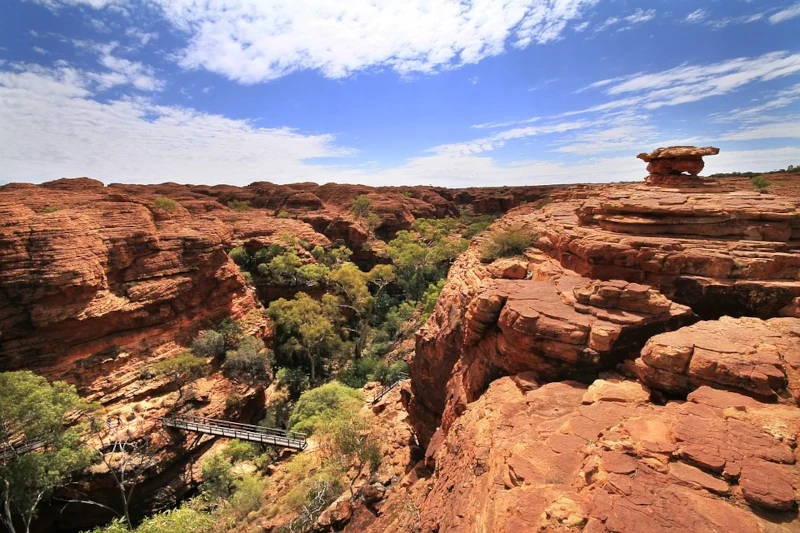
Kings Canyon Facts
- This magnificent geological feature, with its stark, rugged beauty, is best known by the aptly applied term of Kings Canyon. Though certainly not the best known canyon on earth, it nevertheless garners a great deal of interest from tourists to its region.
- Naturally, the local Indigenous Peoples long knew of the existence of this impressive natural feature. Exactly when they first found it, though, presently remains undetermined. Archaeological research into this mystery continues at this time.
- Discovery of the stunning canyon by non-natives only occurred in comparatively recent times, however. The British-born explorer, Ernest Giles, holds the credit for being the first European to view the site. This he managed during his explorations in 1872.
- The breathtaking Kings Canyon presently represents a moderately popular tourist destination in its region. This holds true despite its relatively remote location. The ruggedness of the surrounding terrain further serves to dissuade many visitors.
- This fact, though, helps to maintain it in its natural state. Part of the remarkable formation also forms a sacred site to the local indigenous population. Visitors to the spot are therefore strongly discouraged from straying from designated paths.
Related Articles
Kings Canyon Physical Description
The awe-inspiring beauty of Kings Canyon exists regardless of sheer physical size. That’s because, while it easily impresses all who visit it, the site doesn’t do so due to this aspect of its nature. In these terms, it’s relatively small. Nature, though, doesn’t care about such things.
More precisely, the amazing scenery provided by this canyon is concentrated into a total length of only about 0.62 mi (1 km). Yet the geological processes that created this masterpiece crammed a veritable cornucopia of natural marvels into that dazzling package.
Although certainly not as deep as some similar sites around the world, it nonetheless boasts some respectable measurements. Across its length, its walls reach an average height of roughly 328 ft (100 m). At its deepest point, however, this stretches to about 656 ft (200 m).
Mesmerizing Kings Canyon also provides views to enthrall visitors with its distinctive colors. These primarily consist of multiple shades of red and orange. Shades of brown and ochre also appear, as well. These colors all arise from the nature of the surrounding geology.
The marvels don’t end there, though. Yet another part of this product of time and natural processes manifests in the presence of numerous rock domes. Weathered by time, wind, and water, these strongly resemble similar features found in the awesome Bungle Bungles.
Kings Canyon Location, Formation, and Ecology
The eye-catching gorge so intriguingly named Kings Canyon formed in a part of the world more commonly known for its abundance of distincitve fauna. The same location nevertheless does serve as home to its own share of geological beauty, as well.
To be more exact, however, it formed as part of what now forms the continent of Australia. There, it lies at the western end of the George Gill Range. For those familiar with the area, this places it approximately 201 mi (323 km) to the southwest of the town of Alice Springs.
Research conducted by geologists indicates that the site formed around 400 million years ago. The local stone principally consists of a specific type of mineral. It’s best known to professionals as Mereenie Sandstone. Forces deposited that here at the time of its creation.
Evidence further indicates that the underlying strata was deposited in two distinctly separate events. The indication of this can be observed as a thin layer of purple mudstone, or shale, clearly separating the two. That also indicates environmental changes at the time.
Despite the seeming harshness of the local environment, Kings Canyon plays host to an abundance of life. This includes both flora and fauna. Astonishingly, to some, though, a high number of plant species appear here. This even includes trees, such as the ghost gum.
Various mammals and small reptiles also make this site their home, as well. But the majority of fauna found here consists of smaller bird species. These include such avian species as the Zebra Finch, the Gray-Headed Honeyeater, the Spinefex Pigeon, and the Peregrine Falcon.
Species Sharing Its Range
Tree Kangaroo
Check out our other articles on 7 Deceptively Dazzling Deserts, Swell Shark, Grand Prismatic Spring, Smooth Purple Coneflower, Honey Badger, Wood Frog, Komodo Island
